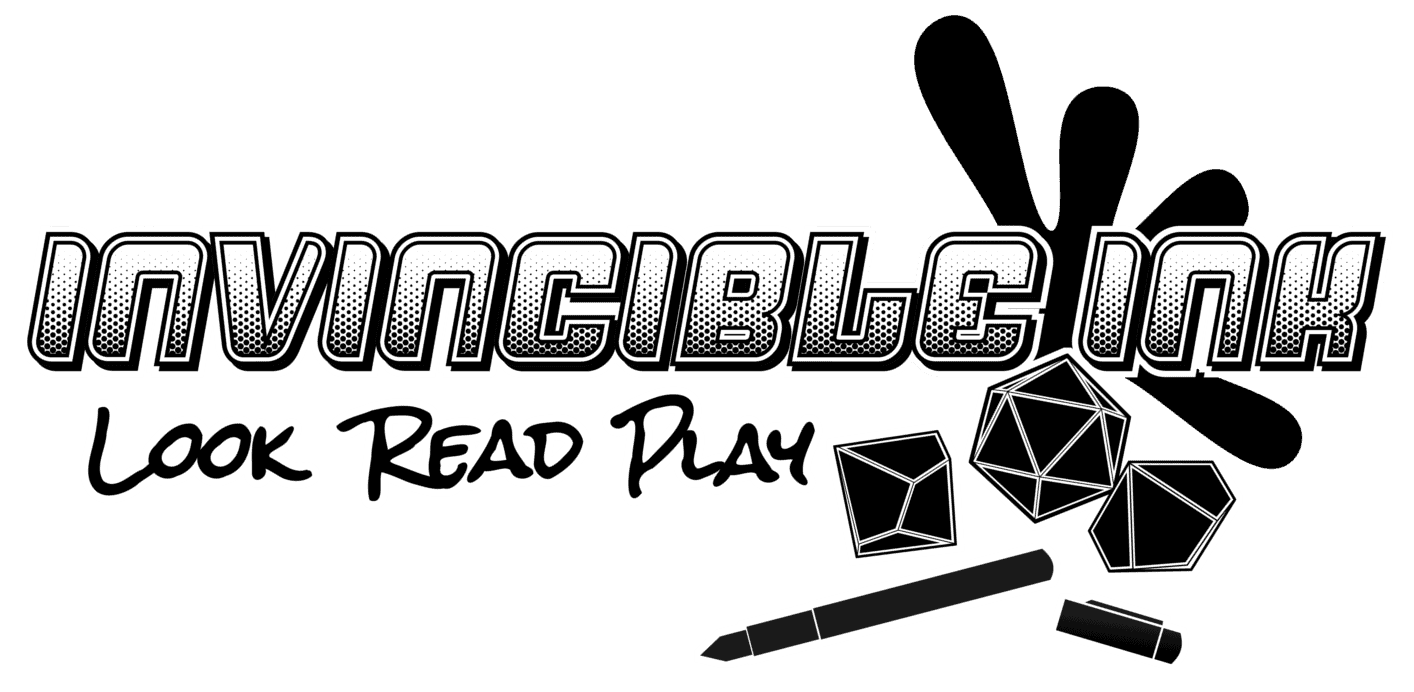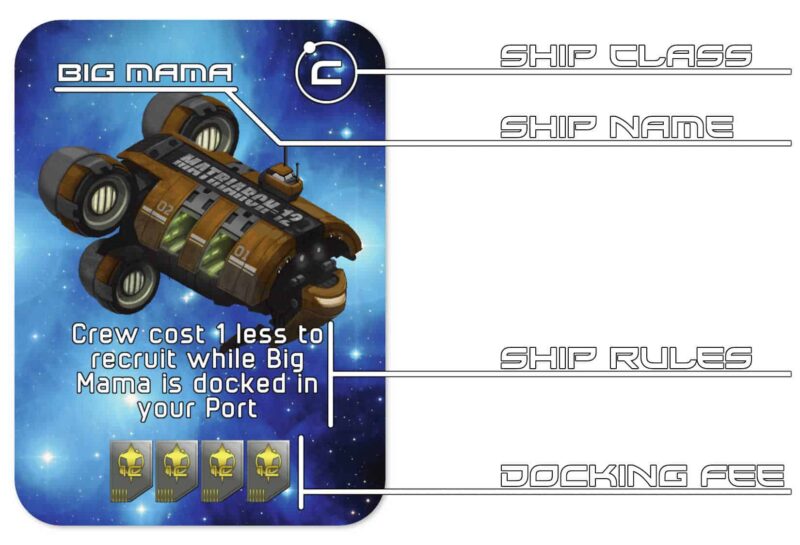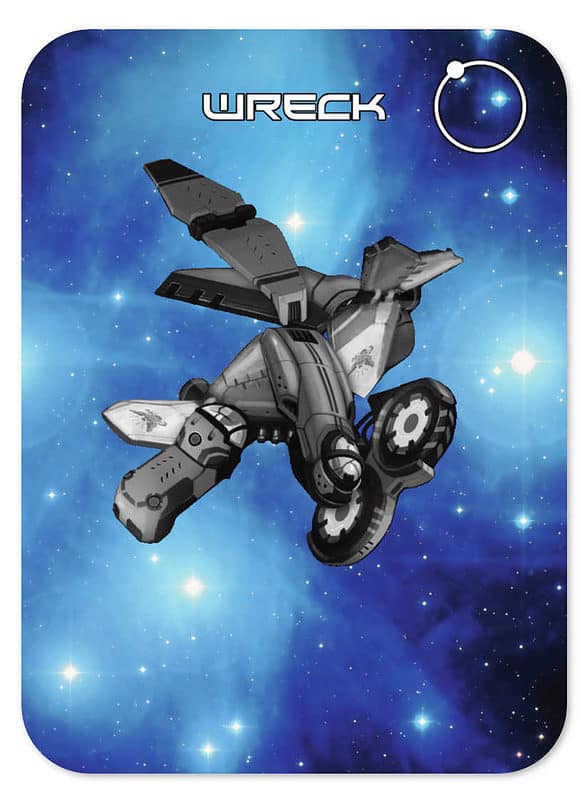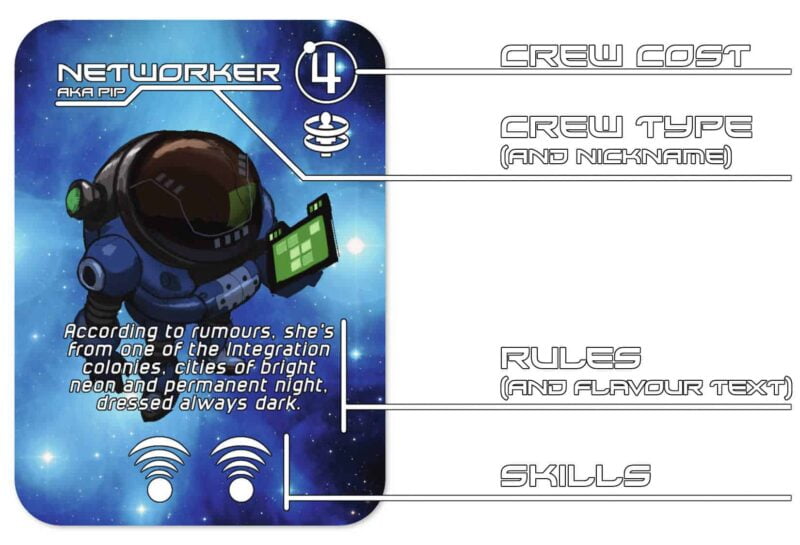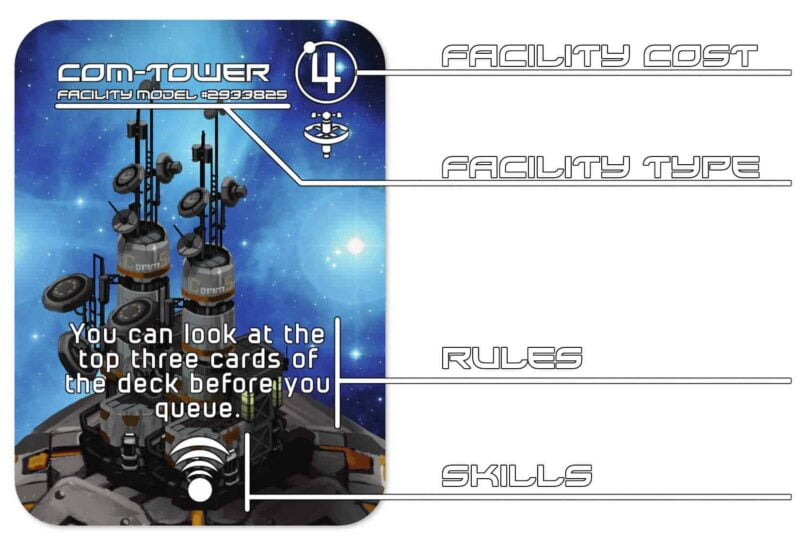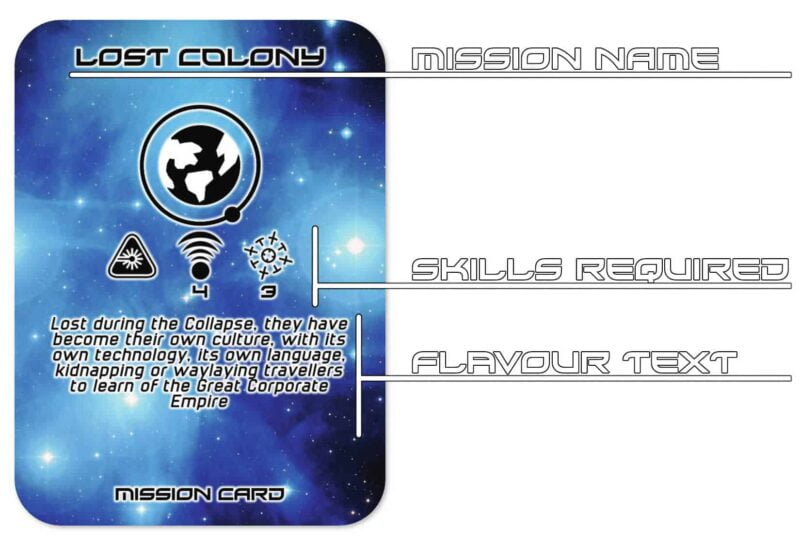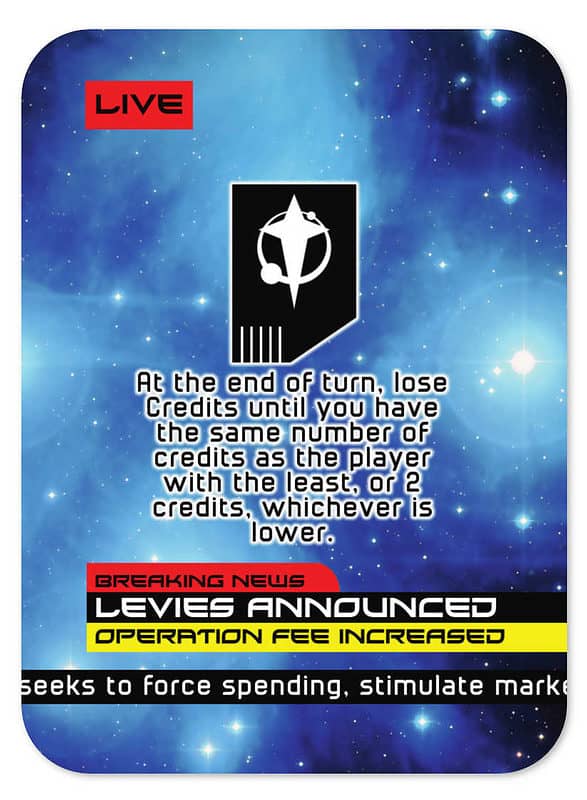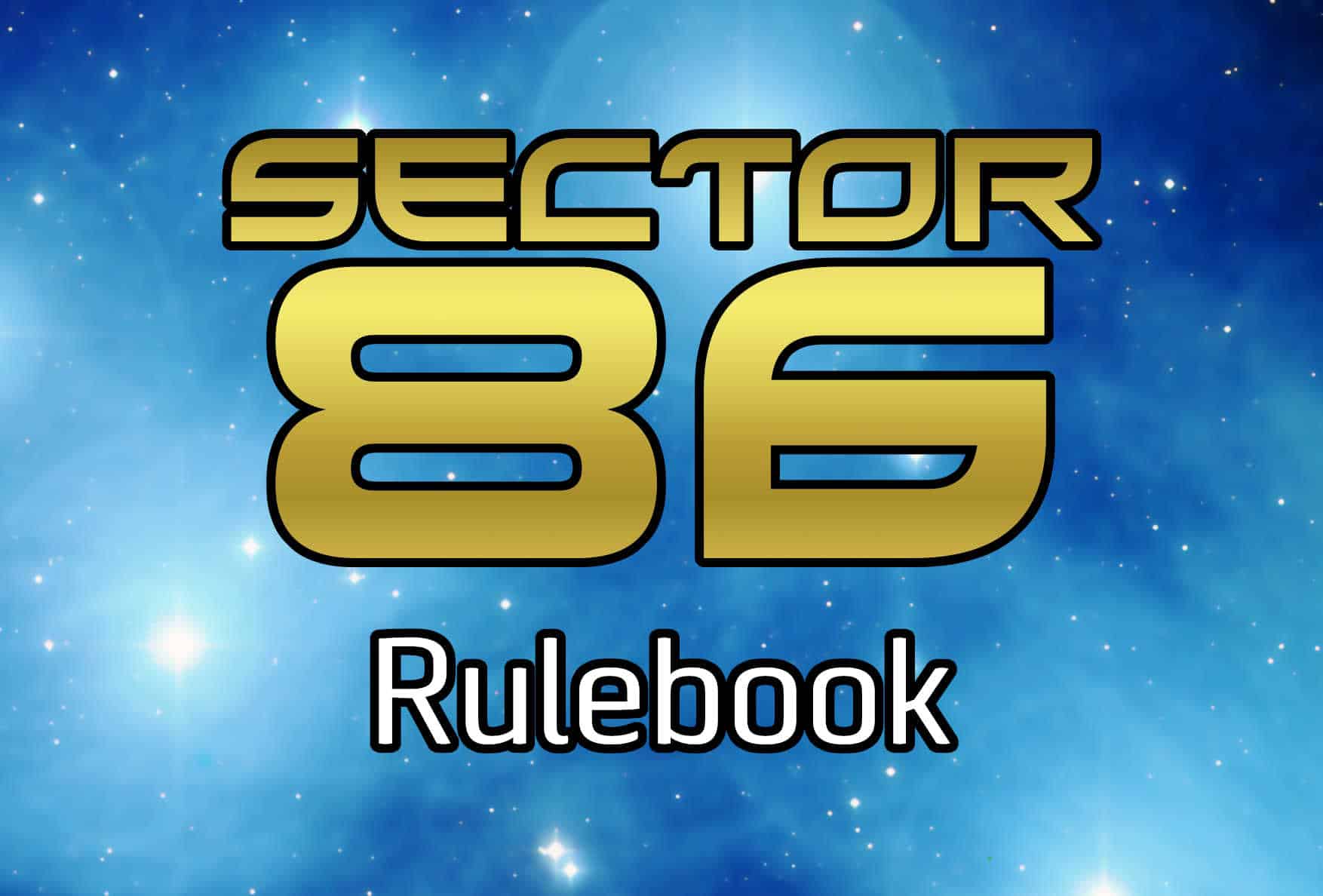
Sector 86 is the place they put you, they say, when you pushed your luck too
hard.
It’s a rough corner of the world. None of the big galactic hubs, but always a lot of people passing through. People need to refuel, reorient, handle dilation effects, deal with other small problems. And so, the sector spaceport system, under the benevolent heel of Corporate Imperial, work to keep space workable, and livable.
Most stations don’t ever care about fixing the place—they want to get promoted out. Maybe you’re not that type. Maybe you’re different.
Access
To play Sector 86 players will need to be able to manipulate the deck. Players will need to lay out cards, and have a common space where they can put the cards that come to their space-port, and which fill the queue. Players do need to do a bit of math—adding or subtracting only—and a little bit of reading.
Players need to be able to communicate with each other about cards they can buy from each other’s queue, and need to be able to handle bidding/conversations about paying one another.
And always: Remember to respect the players and their needs.
Components
In your copy of Sector 86, you should have the following:
- A deck of 120 cards, consisting of:
- 56 Ship Cards
- 33 Crew Cards
- 18 Facility Cards
- 6 Levy cards
- 7 Mission cards
- A cardboard tuckbox
Card Types
There are six types of cards in Sector 86, with the following different card
faces.
Ships
Ship cards represent the classes of vessel that travel through the sector, docking at space ports for stop-offs, then head out again on their journeys.
- Ship Class: This explains what type of port this ship needs to dock in
- Ship Name: This is the name of the ship
- Ship Rules: This is the rules text of the ship
- Docking Fee: This is what the ship pays you when it disembarks
Wrecks
Wrecks are a special kind of kind of ship.
Wrecks have all the components of a ship but don’t operate under any power. You can put a Wreck in any type of port, but it’s only put there so it can be dismantled for scrap. When you scrap a Wreck in your upkeep, you get 1 credit and put the wreck in the discard.
If you have facilities, crews or ships in port that allow for it, Wrecks can be repaired. More on repair later!
Crew
Crew cards represent people who can come to work at your Space Station and be available to be sent on missions.
- Crew Cost: This is how expensive it is to hire the crew member
- Crew Type and Nickname: This indicates the kind of crew and what they specialise in doing. Crew also have unique nicknames.
- Rules and Flavour Text: Some crew have special rules, which is put here. Text in italics is flavour text, there to tell you about the character or the world.
- Skills: These are the skills the crew member contributes to your spaceport, or can contribute to a Mission.
Facilities
Facility cards are spaceport parts you can pay to have attached to your port.
They look like this:
They’re mostly ex-war supply, drifting around by buoyed satellites, and it costs money to get them dragged to your station and have them built onto your spaceport.
- Facility Cost: This is how expensive it is to install this facility
- Facility Type: This is the name of the type of facility
- Rules: These indicate special rules facilities have
- Skills: Some facilities also contribute skills to your spaceport you can use to fulfil contracts
Missions
Mission represent events that move through the sector, making life difficult for people. As a spaceport manager you’re relatively insulated from the effect they have on the sector, but you’re still in a position to help fix them.
- Mission Name: Each mission has a unique name and icon.
- Skills Required: These are the skills any crew sent to resolve this mission need to have to be successful.
- Flavour Text: This explains what the mission represents in this sector of space.
When you want to complete a mission, you have to send crew to do it. You choose to send them on a mission during your Upkeep. To do this, you take crew whose skills, in total, equal the target values on the Mission you want to attempt, and discard them.
You have to send crew—facilities and bonuses from cards like the Unionist don’t work if the Unionist isn’t with the crew you send. If their skill total exceeds the Mission requirements, you succeed at the mission and take the card. It doesn’t go back to the deck.
Levies
Levies cards are orders from Corporate Imperial.
There are three basic types of levies that Corporate Imperial imposes on the sector. They can seek to levy your credits, your facilities, or your crew.
Credits
Finally, each card has a credit on the back. Any time a game gives you credits,
you get them by taking the top card off the deck. You can’t turn credits over:
They are your currency. When you pay for something with credits, put them
face-up in the discard pile.
How To Play
The Sector is a rough place, with a lot of problems that drift in and out of your orbit. Maybe you want to make enough headway with Corporate Imperial to escape the sector and get promoted elsewhere. Maybe you want to clear
our name with information available through illicit networks. Maybe you want to improve the sector just in the principle that you live here and you want it to be a nice place to live.
How To Win
You win the game by successfully completing three different missions.
Setup
To start the game, shuffle the deck, then give each player three face-down cards from the top of the deck, their starting credits. Then pass the deck to the player who has most recently annoyed a corporation1.
1 Or pick a first player at random, whatever
Turn Structure
Play goes in turn, with each player’s turn proceeding like this:
- Upkeep
- Queuing
- Docking
- Recruiting
- Discarding
Upkeep
On your very first upkeep, nothing happens!
But normally in your upkeep, you decide which of the ships docked in your vessel to let disembark. Disembarking vessels pay you their docking fees, then you put them in the discard pile.
If you have any Missions or Facilities providing Contracts, you can fulfil them now and collect payment. During this phase, you have to decide if you’re going to send crew out on a Mission.
On your very first upkeep, none of this stuff can happens, so just move on.
Queuing
In the queuing phase, you flip cards from the top of the deck until:
- You choose to stop, or
- You have a port collision
Each ship that you flip has a port displayed on it, indicating what it needs to dock. If you have more ships coming to your spaceport than you have docks for, that’s a port collision. By default, you have one each of the three types of ports: an A-class port, a B-class port, and a C-class port.
Whenever there’s a a port collision, protocol is to clear the broadcast, taking the entire queue and putting it in the discard pile, ending the turn and moving on to the next player. That’s not required; you can pay a small fee of 1 credit to redirect one of the ships in the queue causing the collision.
Redirecting
Redirecting is how you keep your queue from constantly falling prey to port collisions and keep other people attuned to what’s going on in the economy. You choose one of the two ships in the queue causing the collision, pay 1 credit, putting it straight in the discard, then announce which of the ships you’re redirecting.
At this point, any other player can, if they want, and they have an open port of the appropriate type, pay you 1 credit and have the ship come to their port instead of going to the discard.
If they do pay for the ship, it goes to their port immediately and it’ll be available to disembark on their next turn. They have to make this choice when you redirect the ship.
If more than one player wants that ship, they have to bid credits to you, and the highest payment wins. If players bid the same amount of credits to get that ship, though, the ship goes to the player whose turn is closest to next.
Missions
During the Queueing phase, when you flip over a Mission, take it out of the queue and set it aside where everyone can look at it. This is an active mission, meaning there’s a chance for people to do something about it.
There can only be as many active missions as there are players. Whenever you flip a new one, set it aside and, if you have more missions than players, put the oldest mission in play into the discard.
Docking
Once you decide to stop flipping cards—ending your broadcast—it’s time to dock the ships that are in the queue. Take those cards out of the queue and position them in front of you in separate spaces, showing they’re each in different ports. Players need to be able to see each others’ ports.
If a ship has a Contract on it, you can fulfil its contract as it docks. If you can’t, at this point, then you can’t fulfil the contract for this ship this turn. Once your ships are docked, this phase ends.
Docking Wrecks
One special thing to remember when you’re docking is you can put a wreck in any port you like, A B or C. This is also when you determine, if you can, if you’re going to repair a wreck, and what that means.
Repairing Wrecks
When there’s a wreck in your port, if you can repair it, thanks to facilities, crew or ships docked in your port, you repair it by flipping cards from the top of the deck until you find a ship of that port’s type. Replace the wreck with the ship of that type, and put all the revealed cards and wreck into the discard.
This ship will be available to disembark on your next turn as if it was a normal ship.
Recruiting
Once ships are docked, you have a chance to recruit characters or facilities from the queue to improve your space port.
To recruit a character or buy a facility, you need to be able to pay the cost in the top right corner of the card—indicating how many credits that card demands to come move into your facility.
If a facility is added to your base, it doesn’t do anything until your next turn. If you recruit crew, you can’t use their abilities to fulfil contracts until your next turn. They need time to settle in, c’mon.
Discarding
The last part of the turn comes when you’re about to discard the queue. First, any levies that do something ‘at end of turn’ check now.
Then, any other player can look at your queue and recruit crew or facilities out of it if they’re willing to pay 1 credit extra, to you, for the privilege. Again, if two players want to buy the same thing, they have to offer bids to you for them, and if they are tied, the player whose turn comes up nearest to next wins.
Then you take the remaining cards in the queue and put them into the discard. Then it’s the next player’s turn.
Wrap-up
And that’s it! That’s how to play a whole turn of Sector 86. Hand the deck to the next player, and they can go through the whole turn.
Weird Stuff
There are some corner cases that can happen in the game, so let’s cover them:
Running Out Of Deck
Any time you need to do anything with the deck and there aren’t enough cards in it, you work with all the cards in the deck you can, then shuffle the discard and put it in place of the deck.
Example: Three ships leave your port paying twelve credits in docking fees. There are only four cards left in the deck. You put your ships in the discard pile, then take the top four cards of the deck as credits, shuffle the discard pile and it becomes the new deck. Then take the remaining eight credits from the deck and play continues as normal.
Example: You repair a wreck in your C port, and there are no C class ships left in the deck, you shuffle the discard deck up, and continue flipping cards until you find one.
There’s a possibility in this example that you run the deck out a second time and find literally no options to repair your wreck into. In that case, the action fails. This is rare but it can happen.
Really Running Out Of Deck
There is a chance that if every single player resolves to do it, and gets lucky so the cards that demand payment from the players are all turned into money, that the players can be simply sitting on huge piles of money until the entire deck becomes basically too small to pay fees.
If that’s the case, congratulations, you money-hoarding schemers. You have locked up the economy of the sector and become new, cruel oligarchs. This is why the game tries to keep money flowing from players to the discard and vice versa. This also means nobody can win the game.
The Unionist
The Unionist only improves the skills a character has. So a character like M30W gets +1 Communications and +1 Maintenance from the Unionist, but she doesn’t also get +1 Assault.
The unionist also only improves the skills of characters who are with them: So if you want a team doing a mission to get a bonus, you need the Unionist to go on the mission.
Also, the unionist improves their own skills, but only once; so when you spend 2 credits to (for example) give a Unionist +1 Comms, their bonus kicks in and they have 2 Comms. But if you spend another 2 credits, you only increase the Unionists’ Comms by 1. If you then spent 2 credits to give that same Unionist 1 Assault, the Unionist’s bonus would affect that too, giving them a total of 2 Assault. In this example, you’d have spent 6 credits to get a Unionist with 3 Comms and 2 Assault.
The Terrapin + Repair
You can repair a wreck while a terrapin is parked in the same dock. Terrapin vessels are really lightweight and take up very little space comparative to even other A-class vessels.
Glossary
Here’s a quick summary of card types and how to understand them.
- Contracts: A contract is something that you can do to earn extra money in a turn. If you have, amongst all your crew and facilities, the skills the contract asks, you can just do them. You don’t use them up—so if three different ships have the same contract, you don’t need three times the requirement, you can just succeed at all three at once.
- Credits: Credits are the currency used in this sector to control trade. You represent a credit with a face-down card, taken from the top of the deck. You can’t look at Credits’ other side-they are a mystery!
- Crew: The people travelling around in this region of space. Crew are the people who live at your station. Each crew card has a cost, and can have either game rules or skills. Crew can’t do anything the turn you buy them.
- Facilities: These are permanent structures that change what your spaceport can do. They let you have extra ports or give you special abilities or contracts. Some facilities even give you skills for fulfilling contracts.
- Levies: Levy cards represent the Imperial Corporation doing things in your sector that you, as a space-port manager, have to respond to. These will usually be extra fees on your facilities or a general tax. Levy cards are discarded at the end of turn.
- Missions: Mission cards represent problems in the sector. Missions are also the way you win the game—you need to succeed at three different missions.
- Port Collision: What happens when your queue features too many ships of the same class that can’t dock at your base. In event of a Port Collision, in order to prevent any high-speed vessels crashing into one another, you clear the queue and pass play to the next turn.
- Redirect: Redirecting is how you send a single vessel from your queue out to avoid a port collision. To redirect, you pay 1 credit. Then another player can pay you 1 credit to have the ship sent to their port.
- Repair: Some cards let you repair wrecks that are docked in your port. To repair a wreck, first check which port the wreck is parked in. Then, flip cards from the top of the deck until you find a ship of the same class, and put it into that port. Then put the wreck, and all the other cards, into the discard.
- Ships: Ships are the vessels travelling around in the area. Each ship has a game rule on it, a class, and a docking fee.
- Skills: Crew and some facilities have on them the following three symbols: Maintenance, Communications, and Assault. These are skills. Skills can be used to pay for contracts (see above) or complete missions (see above).
- Wrecks: Wrecks represent tattered, busted remnants of ruined ships, degraded and abraded over time by their time in space. By default, all you can do with a Wreck is scrap it for a single credit in your upkeep. When you do that, put it in the discard pile.
Credits
Game, Rulebook: Talen Lee
Flavour, Naming: Rachel Stevens
Art: Shaman’s Stock Assets, Game-Icons.net
Special Thanks
To Hazel, for talking through the game loop
To Rachel, for naming vessels
To Fionna, From The Internet
Crew card nicknames were inspired by: Allison, Bengineering, Calvin, Casey, Dani, Doc, Fox, Jeb, Katelyn, Kelly, Librus, Mia, Pippa, Rachel, Roxy, Tachyon, Terry, and Tippy.
